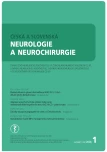Low-pressure hydrocephalus
Authors:
T. Radovnický; F. Vokálek; K. Pištěk; M. Sameš
Authors‘ workplace:
Neurochirurgická klinika Fakulty zdravotnických studií Univerzity J. E. Purkyně a Masarykovy nemocnice v Ústí nad Labem, o. z., Krajská zdravotní, a. s.
Published in:
Cesk Slov Neurol N 2024; 87(1): 18-21
Category:
Review Article
doi:
https://doi.org/10.48095/cccsnn202418
Overview
Low-pressure hydrocephalus (LPH) is a serious disease characterized by ventricular dilatation and clinical signs of intracranial hypertension, although the pressure of the cerebrospinal fluid (CSF) in the cerebral ventricles is below the normal range. The pathophysiology of LPH remains complex and not fully understood, but it seems that a combination of mechanisms involving isolation of the ventricular system from the subarachnoid space, changes in brain tissue elasticity and compliance, and increased brain tissue permeability may play a key role. The diagnosis of LPH should be considered in patients with clinical signs of intracranial hypertension and ventricular dilatation on imaging with preserved patent CSF drainage and normal pressure settings. Treatment of LPH includes temporary therapy to ensure patient stabilization with external ventricular drainage and gradual weaning from drainage with the use of increasing intracranial pressure. Permanent treatment includes endoscopic ventriculostomy of the third ventricle and implantation of a shunt with a low differential pressure setting. The choice of the type of shunt may be individualized; only the lumbo-peritoneal type is not recommended. It should be emphasized that recognition and proper treatment of LPH are crucial, as improper treatment can lead to fatal consequences. Despite the ongoing challenges in the diagnosis and treatment of LPH, it is important that the disease is well known to the professional community.
Keywords:
Ventriculostomy – shunt – low-pressure hydrocephalus – external ventricular drainage
Sources
1. Rekate HL. A contemporary definition and classification of hydrocephalus. Semin Pediatr Neurol 2009; 16 (1): 9–15. doi: 10.1016/j.spen.2009.01.002.
2. Dandy WE, Blackfan KD. An experimental and clinical study of internal hydrocephalus. JAMA 1913; 61: 2216–2217. doi: 10.1001/JAMA.1913.04350260014006.
3. Adams RD, Fisher CM, Hakim S et al. Symptomatic occult hydrocephalus with „normal“ cerebrospinal-fluid pressure. A treatable syndrome. N Engl J Med 1965; 273: 117–126. doi: 10.1056/NEJM196507152730301.
4. Ingram TT. “Low-pressure hydrocephalus.” Dev Med Child Neurol 1971; 13 (5): 676.
5. Singounas EG, Krasanakis C, Karvounis PC. Observations on the pathogenesis of low pressure hydrocephalus. Analysis of 25 cases. Neurochirurgia (Stuttg) 1976; 19 (1): 22–25. doi: 10.1055/s-0028-1090384.
6. Pang D, Altschuler E. Low-pressure hydrocephalic state and viscoelastic alterations in the brain. Neurosurgery 1994; 35 (4): 643–655; discussion 655–656. doi: 10.1227/00006123-199410000-00010.
7. Bannister CM. A report of eight patients with low pressure hydrocephalus treated by C.S.F. diversion with disappointing results. Acta Neurochir (Wien) 1972; 27 (1): 11–15. doi: 10.1007/BF01402168.
8. Keough MB, Isaacs AM, Urbaneja G et al. Acute low-pressure hydrocephalus: a case series and systematic review of 195 patients. J Neurosurg 2020; 135 (1): 300–308. doi: 10.3171/2020.4.JNS20476.
9. Rekate HL, Nadkarni TD, Wallace D. The importance of the cortical subarachnoid space in understanding hydrocephalus. J Neurosurg Pediatr 2008; 2 (1): 1–11. doi: 10.3171/PED/2008/2/7/001.
10. Lesniak MS, Clatterbuck RE, Rigamonti D et al. Low pressure hydrocephalus and ventriculomegaly: hysteresis, non-linear dynamics, and the benefits of CSF diversion. Br J Neurosurg 2002; 16 (6): 555–561.
11. Olivero WC, Wszalek T, Wang H et al. Magnetic resonance elastography demonstrating low brain stiffness in a patient with low-pressure hydrocephalus: case report. Pediatr Neurosurg 2016; 51 (5): 257–262. doi: 10.1159/000445900.
12. Hakim S, Venegas JG, Burton JD. The physics of the cranial cavity, hydrocephalus and normal pressure hydrocephalus: mechanical interpretation and mathematical model. Surg Neurol 1976; 5 (3): 187–210.
13. Peña A, Harris NG, Bolton MD et al. Communicating hydrocephalus: the biomechanics of progres- sive ventricular enlargement revisited. Acta Neurochir Suppl 2002; 81: 59–63. doi: 10.1007/978-3-7091-6738- 0_15.
14. Nagashima T, Tamaki N, Matsumoto S et al. Biomechanics of hydrocephalus: a new theoretical model. Neurosurgery 1987; 21 (6): 898–904. doi: 10.1227/00006123-198712000-00019.
15. Owler BK, Jacobson EE, Johnston IH. Low pressure hydrocephalus: issues of diagnosis and treatment in five cases. Br J Neurosurg 2001; 15 (4): 353–359. doi: 10.1080/02688690120072531.
16. Akins PT, Guppy KH, Axelrod YV et al. The genesis of low pressure hydrocephalus. Neurocrit Care 2011; 15 (3): 461–468. doi: 10.1007/s12028-011-9543-6.
17. Wu X, Zang D, Wu X et al. Diagnosis and management for secondary low- or negative-pressure hydrocephalus and a new hydrocephalus classification based on ventricular pressure. World Neurosurg 2019; 124: e510–e516. doi: 10.1016/j.wneu.2018.12.123.
18. Fried HI, Nathan BR, Rowe AS et al. The insertion and management of external ventricular drains: an evidence--based consensus statement: a statement for healthcare professionals from the neurocritical care society. Neurocrit Care 2016; 24 (1): 61–81. doi: 10.1007/s12028-015-0224-8.
19. Hamilton MG, Price AV. Syndrome of inappropriately low-pressure acute hydrocephalus (SILPAH). Acta Neurochir Suppl 2012; 113: 155–159. doi: 10.1007/978-3-7091-0923-6_31.
20. Foster KA, Deibert CP, Choi PA et al. Endoscopic third ventriculostomy as adjunctive therapy in the treatment of low-pressure hydrocephalus in adults. Surg Neurol Int 2016; 7: 26. doi: 10.4103/2152-7806.178522.
Labels
Paediatric neurology Neurosurgery NeurologyArticle was published in
Czech and Slovak Neurology and Neurosurgery

2024 Issue 1
Most read in this issue
- Diffuse glioma overview based on the 2021 WHO classifi cation part 2 – pediatric type
- Tonsilla cerebelli – anatomy, function and its significance for neurosurgery
- Standardization of MRI in Multiple Sclerosis Management Consensus by the Czech Expert Radiology-Neurology Panel
- Ischemia of corpus callosum
